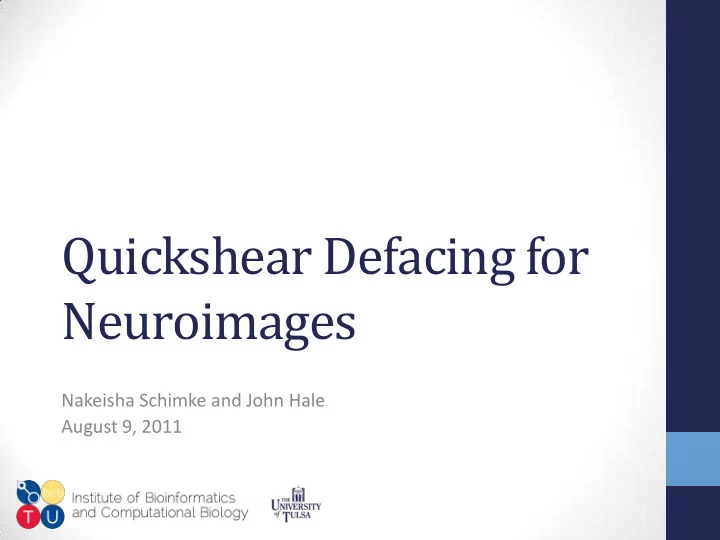

Quickshear Defacing for Neuroimages Nakeisha Schimke and John Hale August 9, 2011
Neuroimages • Contain two elements • Metadata: names, identifiers, dates, etc. • Pixel data
Volume Rendering from Neuroimages Rendering using Slicer (left), AFNI (middle), MRIcron (right).
Existing Image De-identification Methods • Skull stripping • MRI Defacer (Bischoff-Grethe et al. 2007) Image from Bischoff-Grethe et. al, “A technique for the deidentication of structural brain MR images,” 2007.
Quickshear Defacing • Identify brain mask • Create flattened edge-of-brain mask • Find convex hull • Identify plane that divides volume • Set voxels on face side to zero • Input: Original image, Brain mask • Output: Defaced image
Creating Brain Mask • Skull stripping techniques identify brain and non-brain tissue • Works with any skull stripped volume • Create edge of brain mask
Convex Hull • Identifies area to protect from shearing • Cutting along consecutive points on convex hull ensures all brain voxels lie on one side
Quickshear Defacing • Shearing occurs along the line formed by the two points on the hull with the smallest x-coordinate • A buffer is added to preserve brain tissue • All voxels that fall on the face side of the plane are set to zero
Testing Quickshear • Data from MRI Reproducibility Study (Landman et. al, 2010) • 42 images from 21 subjects • T1-weighted MP-RAGE • MRI Defacer run using provided atlas • Quickshear Defacing using brain masks generated from three skull stripping techniques: AFNI 3dSkullStrip, FSL BET, and FreeSurfer HWA • Verification against brain masks using AFNI 3dSkullStrip, FSL BET, and FreeSurfer HWA • Validation using OpenCV Face Detector
Quickshear vs MRI Defacer Defaced images using Quickshear (top) and MRI Defacer (bottom)
Results – Brain Volume Preservation Brain Mask Defacing Method 3dSkullStrip BET HWA MRI Defacer 408.74 (12) 75271.93 (42) 422.00 (7) Quickshear 3dSkullStrip 0.00 (0) 5560.76 (13) 0.00 (0) BET 0.21 (1) 0.00 (0) 1.00 (2) HWA 0.00 (0) 7587.24 (12) 0.00 (0) Average number of voxels discarded (Number of images with voxels discarded)
Results – Facial Feature Recognition Defacing Method Faces detected MRI Defacer 9 Quickshear 3dSkullStrip 10 BET 10 HWA 12 Number of images with faces detected by OpenCV Quickshear defaced image with face detected.
Quickshear — Conclusions • Preserves more brain tissue • Effectively defaces neuroimages • Does not require previously constructed face atlas • Significant performance gains • Integrates seamlessly into the neuroimaging workflow
Acknowledgments • William K. Warren Foundation
Recommend
More recommend